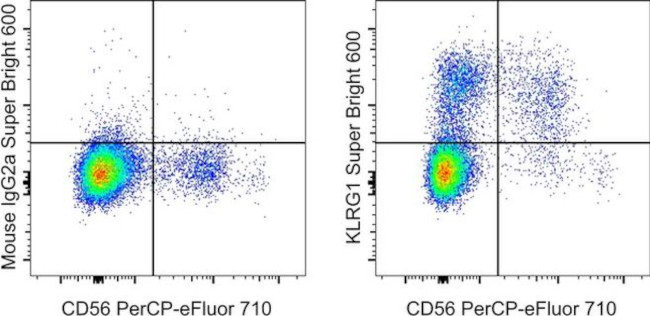Invitrogen
KLRG1 Monoclonal Antibody (13F12F2), Super Bright™ 600, eBioscience™
FIGURE: 1 / 4
KLRG1 Antibody (63-9488-42) in Flow




Product Details
63-9488-42
Species Reactivity
Published species
Host/Isotype
Recommended Isotype Control
Class
Type
Clone
Conjugate
Excitation/Emission Max
Form
Concentration
Purification
Storage buffer
Contains
Storage conditions
Shipping conditions
RRID
Product Specific Information
Description: This 13F12F2 monoclonal antibody reacts with human killer cell lectin-like receptor subfamily G, member 1 (KLRG1), a type II transmembrane inhibitor receptor of the C-type lectin superfamily that contains an ITIM domain. This inhibitory receptor is expressed on subsets of gamma-delta T cells, NK (CD56dim), CD8+ and CD4+ T Cells. KLRG1 is expressed primarily by cells with an effector/memory phenotype that are short-lived, but capable of immediate effector cell function. Cadherin-E, -N, and -R are ligands for KLRG1. Cadherin/KLRG1 interaction inhibits cytolytic activity and proliferation. The percentage of KLRG1 positive cells can vary considerably, depending on antigen experience.
The clones 13F12F2 and 13A2 appear to recognize a similar epitope based on cross-blocking studies.
Applications Reported: This 13F12F2 antibody has been reported for use in flow cytometric analysis.
Applications Tested: This 13F12F2 antibody has been pre-diluted and tested by flow cytometric analysis of normal human peripheral blood cells. This may be used at 5 µL (0.25 µg) per test. A test is defined as the amount (µg) of antibody that will stain a cell sample in a final volume of 100 µL. Cell number should be determined empirically but can range from 10^5 to 10^8 cells/test.
Super Bright 600 is a tandem dye that can be excited with the violet laser line (405 nm) and emits at 600 nm. We recommend using a 610/20 bandpass filter. Please make sure that your instrument is capable of detecting this fluorochrome.
When using two or more Super Bright dye-conjugated antibodies in a staining panel, it is recommended to use Super Bright Complete Staining Buffer (Product # SB-4401) to minimize any non-specific polymer interactions. Please refer to the datasheet for Super Bright Staining Buffer for more information.
Light sensitivity: This tandem dye is sensitive to photo-induced oxidation. Please protect this vial and stained samples from light.
Fixation: Samples can be stored in IC Fixation Buffer (Product # 00-8222) (100 µL of cell sample + 100 µL of IC Fixation Buffer) or 1-step Fix/Lyse Solution (Product # 00-5333) for up to 3 days in the dark at 4°C with minimal impact on brightness and FRET efficiency/compensation. Some generalizations regarding fluorophore performance after fixation can be made, but clone specific performance should be determined empirically.
Excitation: 405 nm; Emission: 600 nm; Laser: Violet Laser
Super Bright Polymer Dyes are sold under license from Becton, Dickinson and Company.
Target Information
KLRG1 (Killer cell lectin-like receptor G1, MAFA, 2F1-Ag) is a homodimeric member of the lectin-like type 2 transmembrane receptor family whose members contain characteristic immunoreceptor tyrosine-based inhibitory motifs (ITIMs) in their cytoplasmic domains. These ITIMs interact with the SH2 domains of protein phosphatases such as SHP-1. KLRG1 is an inhibitory receptor that is expressed on natural killer (NK) cells and certain T cells. NK cells are involved in the lysis of tumor cells and virus-infected cells, and mediate humoral and cell-mediated immune responses.
For Research Use Only. Not for use in diagnostic procedures. Not for resale without express authorization.
How to use the Panel Builder
Watch the video to learn how to use the Invitrogen Flow Cytometry Panel Builder to build your next flow cytometry panel in 5 easy steps.
Bioinformatics
Protein Aliases: C-type lectin domain family 15 member A; C-type lectin domain family 15, member A; ITIM-containing receptor MAFA-L; Killer cell lectin-like receptor subfamily G member 1; killer cell lectin-like receptor subfamily G, member 1; MAFA-like receptor; Mast cell function-associated antigen; mast cell function-associated antigen (ITIM-containing); natural killer cell receptor
Gene Aliases: 2F1; CLEC15A; KLRG1; MAFA; MAFA-2F1; MAFA-L; MAFA-LIKE; MAFAL
UniProt ID: (Human) Q96E93
Entrez Gene ID: (Human) 10219

Performance Guarantee
If an Invitrogen™ antibody doesn't perform as described on our website or datasheet,we'll replace the product at no cost to you, or provide you with a credit for a future purchase.*
Learn more
We're here to help
Get expert recommendations for common problems or connect directly with an on staff expert for technical assistance related to applications, equipment and general product use.
Contact tech support

